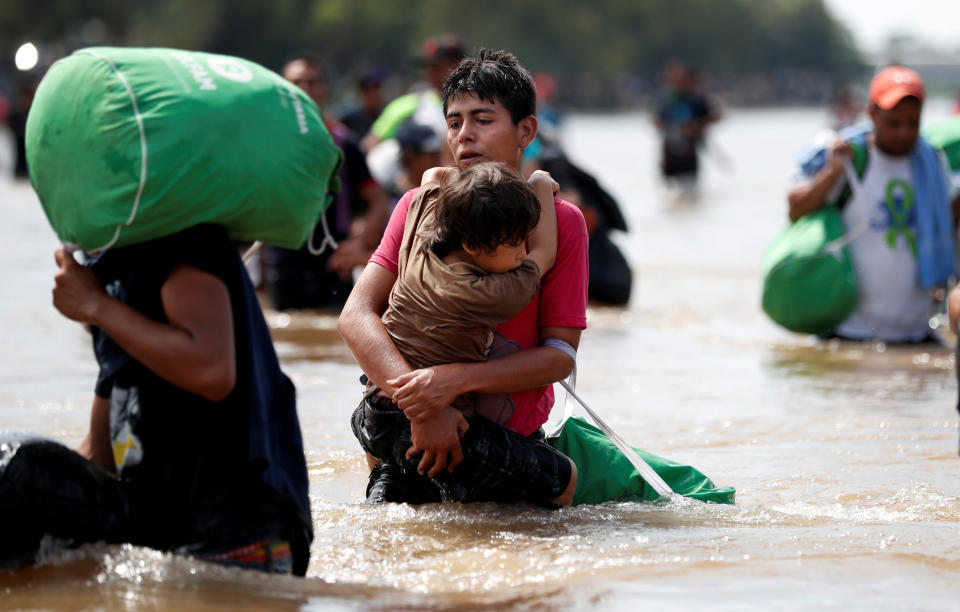Trump bans asylum for migrants who cross the border between official ports of entry
President Trump signed a proclamation Friday morning banning migrants who enter the country between official ports of entry from seeking asylum in the United States. Officials from the Department of Homeland Security and Justice Department told reporters that the proclamation would go into effect at 12:01 a.m. Saturday and be in effect for 90 days.
On Thursday afternoon, administration officials released the text of an interim regulation outlining new restrictions on asylum seekers at the border in anticipation of the president’s proclamation.
The interim rule, which will be published in the Federal Register and open for public comment Friday morning, establishes “a mandatory bar to asylum eligibility” for refugees crossing the southwestern border between official ports of entry. It contains a finding that granting asylum in those circumstances “would be detrimental to the interests of the United States.”
During a call with reporters Thursday afternoon, senior administration officials explained that Trump would be exercising the same “use of authority that the Supreme Court upheld in Trump v. Hawaii,” better known as the travel ban case, to make such a determination about migrants who enter the U.S. from Mexico.

Under existing U.S. law, anyone who is physically present in the country is eligible to apply for asylum here, regardless of how they entered the country. Many Central American asylum seekers, and others who pass through Mexico from other parts of the world, cross the border unofficially and wait to be apprehended by Border Patrol officers. Others present themselves at official ports of entry, of which there are 48 between San Diego and Brownsville, Texas. But the procedure for dealing with them has been the same: Anyone who expresses a fear of returning to their home country is referred to an asylum officer with U.S. Citizenship and Immigration Services, who conducts what’s known as a “credible fear” interview to assess whether the person has a “well-founded fear” of persecution because of race, religion, nationality, political opinion or membership in a particular social group. If they qualify, the practice has been to release them into the population for a hearing on granting asylum status, which can take months or years.
President Trump has vowed to end that “catch-and-release” practice.
Under the new regulations, senior administration officials explained Thursday, border agents will now determine whether immigrants apprehended at the border are subject to the president’s forthcoming proclamation and, if so, any claims of fear will automatically be denied.
Trump was widely expected to announce new policy changes to the asylum process during an address at the White House last week. However, he offered only vague pledges to end “catch and release” and build “massive cities of tents” to house asylum seekers “for a long time if necessary.” The speech was widely viewed as an attempt to stoke fears about the caravan of Central American migrants heading for the border, which he had made a centerpiece of his messaging for the midterms.

CNN reported Thursday that the administration was working to finalize language on an executive action aimed at limiting the number of asylum seekers allowed into the U.S. before the president’s departure for Paris on Friday, though it was unclear whether the documents would be ready for Trump to sign by then.
According to NBC News, administration officials were expecting to be sued over the new asylum plan even before it can be implemented. But the network said the White House had decided to go ahead with the regulations, counting on a favorable ruling from the Supreme Court, which has been remade by Trump’s appointment of Brett Kavanaugh to replace retired Justice Anthony Kennedy, who voted with the 5-4 majority against Trump’s earlier travel ban, in Trump v. Hawaii.
Leading up to the midterms, Trump and members of his administration and Republican candidates had pointed to caravans of mostly Central American migrants traveling north through Mexico as evidence of a “border crisis.” They portrayed existing asylum laws as “loopholes” and accused migrants of making fraudulent asylum claims based on a fear of violence or persecution. Experts have repeatedly rejected this characterization.
_____
Read more from Yahoo News:
The CIA’s communications suffered a catastrophic compromise. It started in Iran.
Ending the Qatar blockade might be the price Saudi Arabia pays for Khashoggi’s murder
How Robert Mercer’s hedge fund profits from Trump’s hard-line immigration stance
Trump’s target audience for migrant caravan scare tactics: Women
Photos: Deadly shooting at country dance bar in Thousand Oaks, Calif.




